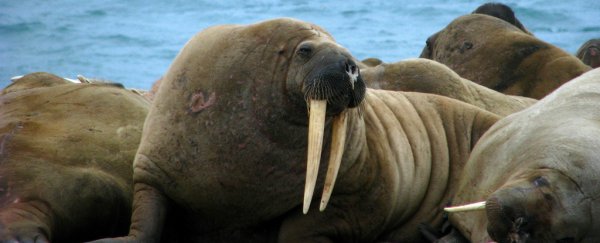For the first time, researchers in Russia have observed wild walruses engaging in complex play using birds - dead or alive - as their toys.
This play involves sneaking up on live birds to scare them away, trying to smack a bird before it takes flight, and – if a dead one happens to be around – using bird carcasses as balls to play underwater catch with.
In other words, walruses bully birds for their own enjoyment, possibly showing that walruses – like many animals – use play as a learning mechanism, with both male and female walruses joining in on the bird-tormenting fun. It's also a stark reminder that, no matter how cute it is, nature can be incredibly brutal.
The team – led by Andrey Giljov, from Saint Petersburg State University in Russia – managed to observe these sinister habits by spending a month on top of a cliff overlooking a walrus population on Kolyuchin Island in the Chukchi Sea.
From this vantage point, which was picked to ensure their observations would go unnoticed by the walruses, the team was able to witness 74 interactions between walruses and a variety of seabirds that call the same area home.
This marks the first time walruses have been observed playing in the water. Before now, it was known that male walruses practice fighting each other on the beach, an act that is most likely meant to prepare them for the battles they will have to win to ensure a mate later in life.
The new type of play observed in this study, though, was performed by both male and female walruses, with younger walruses playing more than older ones.
"The reasons why young walruses engage in such behaviour are probably the same reasons why all animals begin to play," Giljov told Jason Bittel at National Geographic.
"Play may be important for the development of physical and social skills."
So what does this play actually look like? For the most part, the walruses attempted to sneak up on the birds and scare them away and other times the walruses were seen dipping into the water and coming up from underneath the birds, attempting to smack them with their tusks before they managed to fly off.
The strangest thing here is that the walruses did not appear to want to kill the birds they were playing with, hinting that the play wasn't meant to teach them how to hunt.
In fact, out of the 74 interactions, only one bird died from the games, suggesting that the walruses weren't being intentionally harmful - which is easier said than done when you weigh over a tonne and have giant tusks.
That doesn't mean the walruses didn't enjoy a good game of dead bird ball, though, a type of play known as 'object play'.
"The most interesting type of play observed was an object play," Giljov told Bittel, "when one or several walruses used seabird carcasses as 'toys.'"
There were two ways the walruses managed this. The first involved the walruses finding a dead bird, which either died from a predator or natural causes, and then pulling it under water and letting it float back up to the top, like a weird, unsanitary form of catch.
The second is even more fascinating because the walruses actually were seen using the dead birds as what can only be described as an American football. As Bittel puts it for National Geographic:
"In another instance, one walrus grabbed a seabird carcass in its mouth while a group of other walruses formed around it to jostle and lean on the carcass holder. If the carcass holder released its grip, another walrus would snatch the bird up and take its turn in the centre of the circle, sort of like a group of children fighting over a football."
While this marks the first time that walruses have been seen playing with the birds, it also opens up a plethora of questions about why they do it.
For example, many different animals play to learn and socialise. This could very well be the case for the walruses.
Although, on 10 different occasions, the team found that the walruses also ate the dead carcasses after playing an exciting game of dead bird ball with it, leading them to wonder whether or not the act was meant to teach them how to hunt, despite the fact that they weren't trying to kill the birds in the other games.
"Walrus encounters with live birds showed a very low rate of bird kill. Encounters with dead birds were followed by further manipulations with bird carcasses, which included both the consumption of bird soft tissue and object play taking the form of drop–catch behaviour," the team writes in the journal acta ethologica.
This is especially unusual because walruses typically eat fish, not seabirds, though other studies have found that walruses will likely eat anything they can find.
To answer the question fully, researchers will have to learn more about walruses and how play might influence their lives. The new study, the team hopes, will cause more teams to think about walruses in new ways, showing that what was once thought to be a rather dull animal is actually extremely complex.
Until then, just know that there is probably a walrus playing somewhere in the world trying to go pro in a weird game involving a bird carcass.
The team's work was published in acta ethologica.
